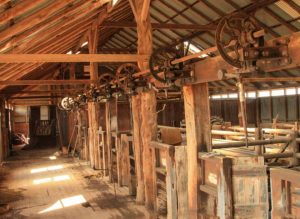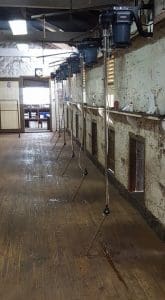
Shaft-driven shearing equipment in a NSW shed.
WOOL growers are replacing antiquated overhead shaft-driven sheep shearing systems after a young woman suffered significant head injuries in a New South Wales shed accident.
Gilgandra woman Casey Barnes late last year had her scalp torn off when her hair was caught in an overhead shaft driving shearing equipment in the NSW wool shed.
Surgery to re-attach her scalp was unsuccessful and her boyfriend Boyd Burn’s sister, Roseanne Burns, began a GoFundMe appeal that raised more than $49,000 to fund skin grafts and medical fees.
Gilgrandra contractor Steven Mudford said Ms Barnes was not working in the shed, but visiting her boyfriend and her father, and had her hair caught while tramping a butt of wool. SafeWork NSW this week urged farmers and sheep shearers to review shearing shed safety following the incident, which it is still investigating.
However, Mr Mudford, whose team was working in the shed at the time of Ms Barne’s accident said the old overhead shaft-driven equipment needed to be banned and he has refused to put teams into sheds who use it.
Mr Mudford said about 10 percent of the 150-plus sheds his shearing teams work in annually still have shaft-driven gear, and many of the owners had already chosen to replace it with single stand electrical overhead machines following the accident.
“There is no need to use them (the shaft-driven machines) and there are safer alternatives.
“I’ve told all my clients we won’t be using shaft-driven gear.”
Mr Mudford believes there are moves to introduce legislation to ban the shaft-driven equipment, but he doubted this would be supported by farmer organisations. One electric shearing machine manufacturer is already reportedly out of stock as wool growers make the conversion to new overhead electric machines with safety cut-out switches.
Australasian marketing manager for Heiniger Australia, Marcus Figueroa, said demand for its Heiniger Evo shearing machine has been reawakened by the NSW accident, but orders have increased nationwide in the last two quarters. The company currently has 600 orders for the machine.
Shearing Supplies NSW salesman Ian Perkins said demand has increased for single stand electric machines, including the Heiniger Evo and the NSW-made Tallibuster. Mr Perkins said wool growers had been phasing out their shaft-driven equipment before the Barnes accident.
Stockowners Shearing managing director Rick Baldock said demand for the Lister Nexus has increased mostly in New South Wales, but also in Victoria, over the past 4-5 weeks. The phasing of shaft-driven gear had been ongoing for sometime, he said.
A SafeWork NSW spoksperson said Work Health and Safety legislation requires employers in all industry sectors to ensure a safe workplace for workers and others who may enter it.
“Wool-growing businesses have the same obligations as all other businesses in NSW to keep people safe.
“Shaft-driven shearing gear, like any other piece of machinery, can create risks if not used safely and appropriately,” the spokesperson said.
“Machinery-related risks can be managed in a variety of ways, including replacement with alternate equipment types, guarding, safe work practices, training and supervision.”
Incident highlights shearing shed dangers

A modern electric shearing machine set-up.
Executive director of SafeWork NSW, Peter Dunphy said the incident highlighted the dangers in shearing sheds and that, despite recent progress, there was still room for improvement in the industry.
“Sheep shearing can be dangerous work with many physical, chemical and biological hazards,” Mr Dunphy said.
“Farmers need to carefully plan work, have safe work practices in place and provide adequate training to prevent injuries to workers and visitors.
“Unfortunately, with 349 shearers injured in the three years to July 2016, it’s clear that this isn’t occurring as well as it could,” she said.
“Once injured, shearers also take twice as long to get back to work as others due to the seriousness of their injuries, so it’s critical that everyone in the shearing industry works together to improve safety.
“That’s why SafeWork NSW is implementing an Agriculture Work Health and Safety Sector Plan.
“The plan aims to deliver safer agricultural workplaces through simple, practical, and affordable strategies, and focuses on a number of issues affecting the sheep shearing industry, including musculoskeletal injuries, mental health, isolation and disease.”
SafeWork NSW’s sheep shearing safety tips:
- Ensure guards are on all shearing machinery.
- Space your workers out to avoid clashing of downtubes.
- Use electric motors on wool presses to reduce noise.
- Regularly maintain all equipment and have safety equipment in place.
- Make sure that emergency stop buttons can be easily reached.
- Keep all walkways clear
- Make sure catching pen floors are dry and non-slip
- Maintain good posture and use your legs instead of your back when moving sheep
- Keep other workers, children and dogs out of the shed
- Have an accessible first aid kit.
- Regularly check and maintain firefighting equipment
- Train new workers and visitors in shearing shed safety.
Mr Dunphy said pre-planning, preparation and consultation were critical to preventing injuries in the shearing shed.
“Shearers and farmers should undertake a pre-shear shed inspection to identify safety issues and ensure they are addressed before shearing commences,” he said.
“A workplace injury can have a devastating effect on a shearer, their family and community, so it’s in everyone’s interest to make safety a priority in the shearing shed.”
SafeWork NSW’s Small Business Rebate Program offers rebates of up to $500 to farmers who make safety improvements to the shearing shed such as replacing old gear with new electric plant or installing guarding on overhead gear to eliminate entanglement risks.
For further information on shearing safety and the Small Business Rebate Program, visit www.safework.nsw.gov.au or call 13 10 50.

I bet you were in Queensland, where they are on the power grid and should be electric machines. As for the accident; who was responsible for putting the wool butt in that position?
No-one uses 60 year-old tractors and headers, so why are we expected to use this old gear? Yesterday I shore in a shed where the bearings were so loud I could not hear the radio or my handpiece, let alone anyone speaking to me. This is 2018 not 1918.
How many millions of sheep have been shorn using shaft-driven gear over the last century or more? How many serious accidents in the same time? In over 60 years in the industry, I have seen the odd person get caught with the old long belt drives, but never directly related to the overhead shaft.